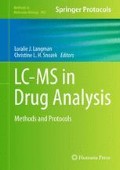Abstract
Abuse of the stimulant cocaine (COC) is a common problem in the United States and elsewhere. The drug can be used either as the powder or as the free base (crack COC), and causes feelings of alertness and euphoria; both forms of COC are powerfully addictive. The assay described here is designed to detect and quantitate parent COC, its major metabolite benzoylecgonine, and a selection of metabolites that can provide specific information about sample validity (m-hydroxybenzoylecgonine), potential toxicity (norcocaine), route of administration (anhydroecgonine methyl ester), and co-utilization with ethanol (cocaethylene).
Access this chapter
Tax calculation will be finalised at checkout
Purchases are for personal use only
References
Isenschmid DS (2003) Cocaine. In: Levine B (ed) Principles of forensic toxicology, 2nd edn. AACC, Washington, DC
Isenschmid DS (2002) Cocaine—effects on human performance and behavior. Forensic Sci Rev 14:61
Cocaine. http://www.usdoj.gov/dea/concern/cocaine.html. Accessed 2 May 2008
NIDA InfoFacts: crack and cocaine. http://www.nida.nih.gov/Infofacts/cocaine.html. Accessed 2 May 2008
Substance Abuse and Mental Health Services Administration (2008) Results from the 2008 national survey on drug use and health: national findings (Office of Applied Studies, NSDUH Series H-34, DHHS Publication No. SMA 08-4343). Rockville, MD
Dean RA, Christian CD, Sample RH et al (1991) Human liver cocaine esterases: ethanol-mediated formation of ethylcocaine. FASEB J 5:2735–2739
Kolbrich EA, Barnes AJ, Gorelick DA et al (2006) Major and minor metabolites of cocaine in human plasma following controlled subcutaneous cocaine administration. J Anal Toxicol 30:501–510
Moore C, Negrusz A, Lewis D (1998) Determination of drugs of abuse in meconium. J Chromatogr B: Biomed Sci Appl 713:137–146
Lester BM, ElSohly M, Wright LL et al (2001) The maternal lifestyle study: drug use by meconium toxicology and maternal self-report. Pediatrics 107:309–317
Klette KL, Poch GK, Czarny R et al (2000) Simultaneous GC–MS analysis of meta- and para-hydroxybenzoylecgonine and norbenzoylecgonine: a secondary method to corroborate cocaine ingestion using nonhydrolytic metabolites. J Anal Toxicol 24:482–488
Inaba T, Stewart DJ, Kalow W (1978) Metabolism of cocaine in man. Clin Pharmacol Ther 23:547–552
Farre M, de la Torre R, Llorente M et al (1993) Alcohol and cocaine interactions in humans. J Pharmacol Exp Ther 266:1364–1373
Hart CL, Jatlow P, Sevarino KA et al (2000) Comparison of intravenous cocaethylene and cocaine in humans. Psychopharmacology 149:153–162
Brzezinski MR, Abraham TL, Stone CL et al (1994) Purification and characterization of a human liver cocaine carboxylesterase that catalyzes the production of benzoylecgonine and the formation of cocaethylene from alcohol and cocaine. Biochem Pharmacol 48:1747–1755
McCance-Katz EF, Price LH, McDougle CJ et al (1993) Concurrent cocaine-ethanol ingestion in humans: pharmacology, physiology, behavior, and the role of cocaethylene. Psychopharmacology 111:39–46
Smith RM (1984) Ethyl esters of arylhydroxy- and arylhydroxymethoxycocaines in the urines of simultaneous cocaine and ethanol users. J Anal Toxicol 8:38–42
Paul BD, Lalani S, Bosy T et al (2005) Concentration profiles of cocaine, pyrolytic methyl ecgonidine and thirteen metabolites in human blood and urine: determination by gas chromatography-mass spectrometry. Biomed Chromatogr 19:677–688
Robandt PP, Reda LJ, Klette KL (2008) Complete automation of solid-phase extraction with subsequent liquid chromatography-tandem mass spectrometry for the quantification of benzoylecgonine, m-hydroxybenzoylecgonine, p-hydroxybenzoylecgonine, and norbenzoylecgonine in urine—application to a high-throughput urine analysis laboratory. J Anal Toxicol 32:577–585
Author information
Authors and Affiliations
Corresponding author
Editor information
Editors and Affiliations
Rights and permissions
Copyright information
© 2012 Springer Science+Business Media, LLC
About this protocol
Cite this protocol
Snozek, C.L.H., Bjergum, M.W., Langman, L.J. (2012). Cocaine and Metabolites by LC-MS/MS. In: Langman, L., Snozek, C. (eds) LC-MS in Drug Analysis. Methods in Molecular Biology, vol 902. Humana Press, Totowa, NJ. https://doi.org/10.1007/978-1-61779-934-1_8
Download citation
DOI: https://doi.org/10.1007/978-1-61779-934-1_8
Published:
Publisher Name: Humana Press, Totowa, NJ
Print ISBN: 978-1-61779-933-4
Online ISBN: 978-1-61779-934-1
eBook Packages: Springer Protocols

